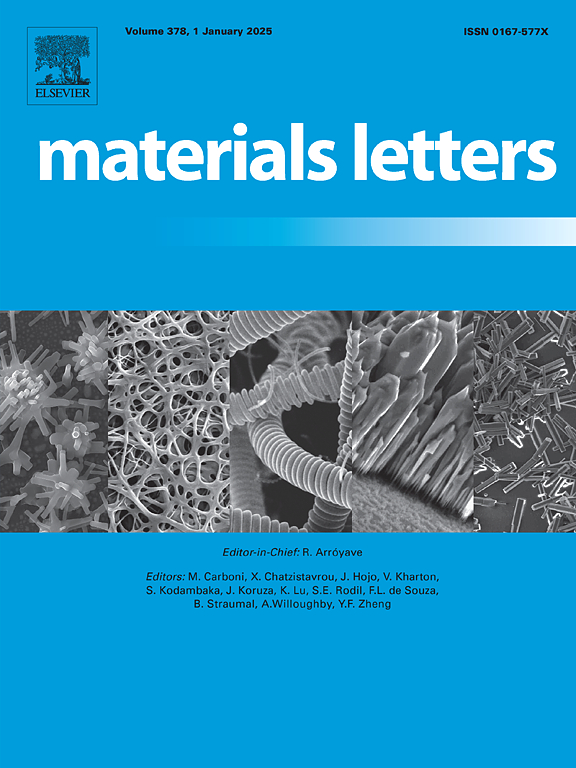Construction of TiO2/crystalline RP heterojunction by interfacial Ti-O-P bond for enhanced charge migration in photocatalysis
IF 2.7
4区 材料科学
Q3 MATERIALS SCIENCE, MULTIDISCIPLINARY
引用次数: 0
Abstract
The technology of converting solar energy into hydrogen through photocatalysis is considered as an effective way to alleviate energy shortage. Elemental red phosphorus (RP) has shown great application potential in the field of photocatalytic hydrogen evolution (PHE) due to its wide light absorption range, and inexpensive, but its high recombination rate of photogenerated carriers limits its wide application. In this paper, crystalline type Ⅱ red phosphorus (CRP) and titanium dioxide (TiO2) heterojunction (TiO2@RP) were constructed by a simple liquid phase method. The characterization results showed that an effective heterojunction interface was formed between CRP and TiO2 by Ti-O-P bond. The construction of TiO2@RP heterojunction promoted the separation of photogenerated charge, which greatly enhanced the PHE performance. The PHE (λ > 420 nm) of as-constructed heterojunction reached 288.8 μmol·g−1·h−1, which enhanced 2.68 times that of CRP. This study will provide a new idea for the rational design of efficient heterojunction photocatalyst.

利用Ti-O-P键构建TiO2/结晶RP异质结,增强光催化中的电荷迁移
通过光催化将太阳能转化为氢气的技术被认为是缓解能源短缺的有效途径。元素红磷(RP)因其光吸收范围广、价格低廉而在光催化氢气进化(PHE)领域显示出巨大的应用潜力,但其光生载流子的高重组率限制了其广泛应用。本文采用简单的液相法构建了晶体Ⅱ型红磷(CRP)和二氧化钛(TiO2)异质结(TiO2@RP)。表征结果表明,CRP 和 TiO2 之间通过 Ti-O-P 键形成了有效的异质结界面。TiO2@RP异质结的构建促进了光生电荷的分离,从而大大提高了PHE的性能。所构建的异质结的 PHE(λ > 420 nm)达到了 288.8 μmol-g-1-h-1,是 CRP 的 2.68 倍。这项研究将为合理设计高效异质结光催化剂提供新的思路。
本文章由计算机程序翻译,如有差异,请以英文原文为准。
求助全文
约1分钟内获得全文
求助全文
来源期刊

Materials Letters
工程技术-材料科学:综合
CiteScore
5.60
自引率
3.30%
发文量
1948
审稿时长
50 days
期刊介绍:
Materials Letters has an open access mirror journal Materials Letters: X, sharing the same aims and scope, editorial team, submission system and rigorous peer review.
Materials Letters is dedicated to publishing novel, cutting edge reports of broad interest to the materials community. The journal provides a forum for materials scientists and engineers, physicists, and chemists to rapidly communicate on the most important topics in the field of materials.
Contributions include, but are not limited to, a variety of topics such as:
• Materials - Metals and alloys, amorphous solids, ceramics, composites, polymers, semiconductors
• Applications - Structural, opto-electronic, magnetic, medical, MEMS, sensors, smart
• Characterization - Analytical, microscopy, scanning probes, nanoscopic, optical, electrical, magnetic, acoustic, spectroscopic, diffraction
• Novel Materials - Micro and nanostructures (nanowires, nanotubes, nanoparticles), nanocomposites, thin films, superlattices, quantum dots.
• Processing - Crystal growth, thin film processing, sol-gel processing, mechanical processing, assembly, nanocrystalline processing.
• Properties - Mechanical, magnetic, optical, electrical, ferroelectric, thermal, interfacial, transport, thermodynamic
• Synthesis - Quenching, solid state, solidification, solution synthesis, vapor deposition, high pressure, explosive
 求助内容:
求助内容: 应助结果提醒方式:
应助结果提醒方式:


